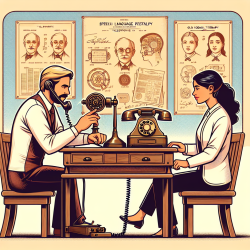Introduction
The evolution of communication technology has profoundly impacted various fields, including speech-language pathology. As professionals dedicated to improving children's outcomes, it's crucial to understand the historical context of telecommunication to enhance our teletherapy practices. The research article "The Lancet on the telephone 1876-1975" by Aronson (1977) offers valuable insights into the development and application of telephone technology, which can inform our current practices in online therapy.
Historical Insights and Modern Applications
The telephone, introduced in 1876, revolutionized communication by enabling real-time conversations over long distances. This innovation laid the groundwork for today's teletherapy services. The article by Aronson (1977) highlights several key aspects of telephone use that remain relevant in modern teletherapy:
- Accessibility: The telephone made communication more accessible, breaking geographical barriers. Similarly, teletherapy provides access to speech-language services for children in remote or underserved areas.
- Adaptability: Over time, the telephone evolved to meet users' needs, from party lines to private connections. This adaptability is mirrored in teletherapy platforms that offer customizable features to cater to individual client needs.
- Reliability: The telephone's reliability was crucial for its widespread adoption. In teletherapy, ensuring stable and secure connections is vital for effective sessions.
Implementing Historical Lessons in Teletherapy
By understanding the historical development of the telephone, practitioners can enhance their teletherapy services in several ways:
- Invest in Reliable Technology: Just as the telephone's reliability was key to its success, investing in robust teletherapy platforms ensures consistent and effective service delivery.
- Focus on User Experience: The evolution of telephone technology was driven by user needs. Similarly, teletherapy platforms should be user-friendly and adaptable to meet the diverse needs of children and their families.
- Embrace Continuous Improvement: The telephone's history is marked by continuous innovation. Practitioners should stay informed about technological advancements and integrate new tools to enhance therapy outcomes.
Encouraging Further Research
While historical insights provide a foundation for improving teletherapy practices, ongoing research is essential to address emerging challenges and opportunities. Practitioners are encouraged to explore the following areas:
- Impact of Technology on Engagement: Investigate how different teletherapy tools affect children's engagement and learning outcomes.
- Equity in Access: Research strategies to ensure equitable access to teletherapy services for all children, regardless of socioeconomic status.
- Data Security: Examine best practices for maintaining data privacy and security in teletherapy settings.
Conclusion
The historical development of the telephone offers valuable lessons for enhancing teletherapy practices. By investing in reliable technology, focusing on user experience, and embracing continuous improvement, practitioners can create better outcomes for children. To delve deeper into the historical insights provided by Aronson (1977), I encourage you to read the original research paper. The Lancet on the telephone 1876-1975.










